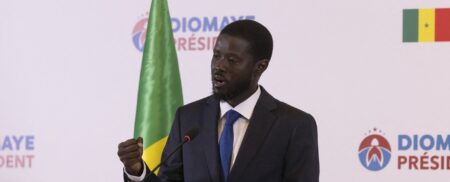- Kenya’s forex reserves have dwindled since last year as dollar scarcity piled pressure on imports amid the high cost of living.
- The latest loan disbursements from the World Bank and the IMF, coupled with diaspora remittances are helping push up Kenya’s forex reserves.`
- On March 10th, a government-to-government deal with Gulf oil firms for the supply of petroleum products was signed to ease pressure on Kenya’s forex reserves.
Nairobi will continue purchasing fuel on credit from three state-owned Gulf oil marketers until December 2024 in a plan the government is banking on to ease piling pressure on Kenya’s forex reserves.
The move comes in the wake of high expenditure on oil imports even as Kenya remains a net importer grappling with a widening trade deficit that hit $10.8 billion last year. Last year, Kenya’s expenditure on imports rose by 17.5 per cent to $16.9 billion (KSh2.5 trillion), despite growing export volumes.
Kenya forex earnings from exports
Earnings from exports of goods grew by 17.4 per cent to $5.9 billion in 2022, Economic Survey 2023 indicates. However, the growth in total exports was not sufficient to offset the rising import bill, resulting in widening deficit in the balance of trade.
According to the Kenya National Bureau of Statistics (KNBS), the rise in imports was largely on account of increasing imports of petroleum products that hit $4 billion. “Imports of petroleum products amounted to KSh597.7 billion, accounting for nearly a quarter of the total import bill in 2022,” KNBS said.
Kenya has also seen a spike in retail fuel prices that hit historic highs in mid-September with a litre of super petrol trading at $1.43 (Ksh211.64) in Nairobi. Diesel, widely used in the transport, large-scale agriculture, and manufacturing industry is going for $1.36 (KSh200.99) a litre.
A litre of kerosene, the fuel mainly used by poor households for cooking and lighting is going for $1.37 (Ksh202.61) in Nairobi.
Read Also: Rising global fuel prices amid a delicate geopolitical shift
Kenya forex reserves performance
Kenya has been experiencing low forex reserves since last year as a dollar scarcity drove up the cost of living. Repayment of dollar-denominated loans, where the weakening shilling continues to push up the value of the country’s external debt, is now a veritable thorn in the flesh of Kenya’s National Treasury.
In March, Kenya’s reserves hit a 10-year low of $6.3 billion, the Central Bank of Kenya data shows. This erosion of reserves came amid high demand by importers for dollars mainly in the energy, manufacturing, and retail sectors.
At $6.3 billion, which was worth 3.5 months of import cover, the reserves fell short of CBK’s statutory requirement to maintain at least four months of import cover. It failed to meet the prescribed 4.5-month cushion recommended by the East Africa Community (EAC) convergence criteria.
Recent loan disbursements mainly by the World Bank and IMF, coupled with stable diaspora remittances are however buffering the reserves. As of last Friday, they stood at $6.9 billion (3.8 months of import cover). But this is below the highs of $8.2 billion or 4.86 months of import cover the country recorded mid-last year.
According to Market Analyst at FXPesa Rufas Kamau, dependence on dollar reserves from exports and diaspora remittances is proving unsustainable since Kenya is a net importer. “The CBK can close the gap by incentivizing foreign direct investments,” Kamau noted.
Read Also: Puzzle of Kenya’s low forex reserves amid huge debt obligations
Loans repayment
Interest payments on loans will rise by a record $1.6 billion on top of the normal payments on principal with Kenya’s debt crossing Ksh10 trillion mark, currently at $68.9 billion (KSh10.2 trillion).
The National Treasury has indicate that interest payments in the financial year ending June 2024 could rise sharply to $6.2 billion, or 33.7 per cent uptick from $4.7 billion. This will be mainly due to the weakening of the shilling that has lost about 19 per cent in value to King Dollar in the last year.
“The increased interest payments are due to the weakening of the Kenya shilling and elevated interest rates in the domestic environment,” Treasury said in its draft 2023 Budget Review and Outlook Paper.
Read Also: Depreciating shilling worsens Kenya’s debt and economic struggles
Fuel on credit
To ease pressure on Kenya forex reserves, on March 10, 2023, Kenya entered into a government-to-government deal with Aramco Trading Fujairah FZE (Aramco), Abu Dhabi National Oil Company (ADNOC), Global Trading Ltd and Emirates National Oil Company (Singapore) Private Limited (ENOC), for the supply of fuel.
“The arrangement was mainly intended to address the US Dollar liquidity challenges and exchange rate volatility caused by the global dollar shortage at the time,” National Treasury Cabinet Secretary Njuguna Ndung’u said.
This exposed the country and the region to the risk of disruption of supply of petroleum.
“From a macroeconomic perspective, the country is set to realize greater benefits from an accumulation of foreign reserves as demand for foreign exchange from the oil sector eases, arising from deferred payments for petroleum,” Prof Njuguna said this week.
A government-to-government deal would also ease speculative tendencies in Kenya forex market that had exacerbated exchange rate volatility and the sharp depreciation of the Kenya shilling.
Exchange rate stability and slow-down in currency depreciation supports economic recovery and slow down the growth of public debt.
Kenya’s exchange rate stability is a regime of floating exchange rate supported by higher levels of forex reserves and provides an effective shock absorber to external economic shocks, further reinforcing investor confidence.
Oil supply payments
So far, letters of credit with a combined value of $238.8 million have already been settled (prepaid before maturity), without distorting the Kenya forex market, Treasury confirmed.
Payment for the entire import of Jet A1 (jet fuel), dual purpose kerosene and the transit portion of super petrol and diesel imports under the government-to-government arrangement is made in US dollar, and such amounts credited to an escrow account.
The Kenya shillings that paid for the local portion of super petrol and diesel imports are credited to a separate escrow account and subsequently converted into US dollar as each individual letter of credit maturity date nears.
Currently, the US dollar escrow account holds $1billion while the Kenya shillings escrow account holds KShs115 billion ($777.8 million), which will ensure timely and seamless payment of all maturing LCs, Treasury said.
“A Treasury and Risk Management Committee (TRIMCOM) composed of government, nominated local oil marketing companies and the financing parties has been closely monitoring the go-to-market dates for USD conversions for various LCs, to ensure timely fulfillment of all LC obligations,” Treasury said.
This move has help to de-risk the government-to-government arrangement with more financing parties have joining in with others at advanced stages.
Read Also: Record-high fuel prices in Kenya amid economic woes
Benefits from the deal
According to Treasury, the government-to-government arrangement has eliminated spot purchases for the US dollar by about 100 oil marketing companies, which previously created speculative pressure in the spot market. “The G-to-G does not therefore in any way expose the country to exchange rate volatility or depreciation, but rather protects the economy from such negative effects,” the Treasury said.
About 35 cargoes have so far successfully docked under the arrangement, assuring the country and the region of continued supply of petroleum products.
The Treasury said the government has also been able to leverage on the economies of scale, resulting from the arrangement to renegotiate for a reduction in the premium and freight charges, at a time when they are on a steep upward trend in rest of the world.
The recent production cuts by OPEC, the ongoing Russia-Ukraine conflict and the approaching winter in the Northern Hemisphere have significantly affected the prior arrangements.
Kenya has also recorded a reduction of up to $30 per metric tonne, which “will greatly cushion the country going forward.”
The government, through the Ministry of Energy and Petroleum and the National Treasury, will continue monitoring the implementation of the government-to-government arrangement, the minister said, to ensure the continued security of the supply of petroleum.
This, as it ensures maximum benefits to the country and the region.
Extended deal
Saudi Aramco, Emirates National Oil Co., and Abu Dhabi National Oil Co. will continue to supply Kenya with refined fuel products, in an agreed extension.
According to the Energy and Petroleum Regulatory Authority Director-General Daniel Kiptoo, the supply will continue until December next year. “There was an extension up to December 2024 so this is arising out of negotiations that have been happening to drive down the freight and the premium,” Kiptoo said during an interview with a local radio station.
The deal comes with 180-day credit terms, allowing the country to build up dollars for the purchase over time, rather than requiring about $500 million every month to pay for fuel imports, which land at the Port of Mombasa for further distribution including exports.











